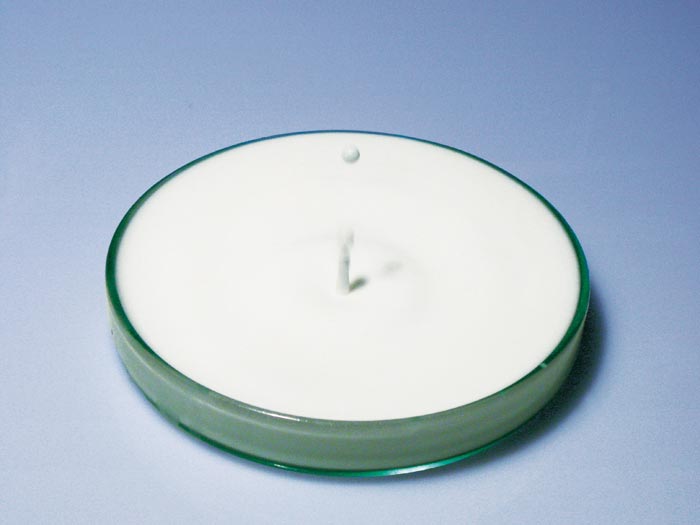CryoSol®Plus – Air conditioning of buildings with phase change slurries

CryoSol®Plus – Dispersion made of water and paraffin. © Fraunhofer UMSICHT
Cryosol®Plus looks like milk. But don't even think about drinking it. While the composition made of paraffins and water is non-poisonous, it still isn't all that tasty. Paraffin is known as wax or as maintenance oil in Vaseline. In CryoSol®Plus, the paraffins serve – finely dispersed – as phase change material (PCM) for heat and hold storage.
The principle: When the dispersion absorbs heat, the solid tiny paraffin balls “melt” into paraffin droplets and store the heat. Once the solution cools down, the droplets become solid again. In CryoSol®Plus, the paraffin exists finely dispersed in water as a heterogeneous blend of substances.
CryoSol®Plus – two to three times the energy density of water
Jointly with the RWTH Aachen university, Fraunhofer UMSICHT has researched the utilization of CryoSol®Plus in supply systems. In principle, the blend can serve as heat transfer fluid, as storage medium for thermal systems, and for cooling. “In a temperature range from 5 to 20 degrees Celsius it is a good alternative to cold water, since it features a two to three times higher energy density”, explains Dipl.-Ing. Tobias Kappels, researcher in the Thermal Energy Storage and Systems group.
In the project, the dispersion was utilized for the storage of nocturnal cold to then dissipate it during the day on a room-by-room basis via capillary tube mats in the ceiling. The idea for constructing the capillary tube mats originates from nature and corresponds to the network of fine nervous system under our skin which not only provides us with nutrition but also serves to regulate body heat. In buildings, the capillary tube mats in ceilings, walls, or floors are utilized for combined area heating or cooling.
Higher transport capacity, better storage
In the project, the dispersion was manufactured, characterized, and tested in a heating/cooling system, and the substance properties of the dispersions were modeled. The utilization of CryoSol®Plus could significantly increase the transport capacity and storage capability of a distribution network.
The utilization of the dispersion is of interest especially to the manufacturing industry, air conditioning, chemical and automotive industry as well as for cooling devices in the foodstuffs industry.
The project was funded for four years in the context of the framework program EnEff: Wärme (Energy Efficiency: Heat) by the German Federal Ministry of Economics and Technology (funding ID 0327471A).
Weitere Informationen:
http://www.umsicht.fraunhofer.de/en/press-media/2014/crysolplus-pcs-energy-storage.html
Media Contact
All latest news from the category: Architecture and Construction
Newest articles

Compact LCOS Microdisplay with Fast CMOS Backplane
…for High-Speed Light Modulation. Researchers from the Fraunhofer Institute for Photonic Microsystems IPMS, in collaboration with HOLOEYE Photonics AG, have developed a compact LCOS microdisplay with high refresh rates that…

New perspectives for material detection
CRC MARIE enters third funding period: A major success for terahertz research: Scientists at the University of Duisburg-Essen and the Ruhr University Bochum have been researching mobile material detection since…

CD Laboratory at TU Graz Researches New Semiconductor Materials
Using energy- and resource-saving methods, a research team at the Institute of Inorganic Chemistry at TU Graz aims to produce high-quality doped silicon layers for the electronics and solar industries….



